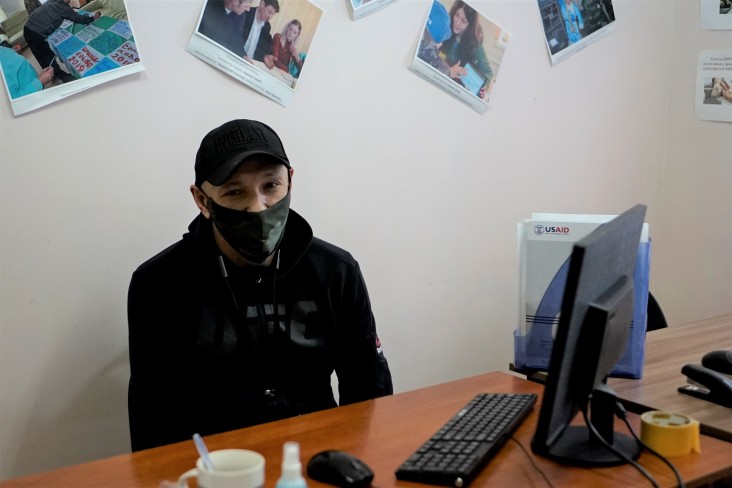Speeches Shim

Progressing toward ending the AIDS epidemic in Central Asia
Alexander is proof that you can live a healthy and fulfilling life with HIV. The 43-year-old contracted the virus 21 years ago when he used to inject drugs. He has since overcome his drug dependence and now works as a peer navigator in Kazakhstan to help others in his situation.
He is part of a USAID-supported network of 162 peer navigators across Kazakhstan, the Kyrgyz Republic, and Tajikistan who help people get tested for HIV, get connected to HIV treatment, and adhere to treatment.
“Some days, I scour the city looking for my clients who have skipped their treatment,” Alexander said.
Despite the COVID-19 pandemic, Kazakhstan, the Kyrgyz Republic, and Tajikistan have continued to make progress toward ending the epidemic. USAID has worked in partnership with these host countries to adapt the HIV program and avoid interruption of HIV service delivery.
In 2016, the Joint United Nations Programme on HIV/AIDS (UNAIDS) set an ambitious global target of 90-90-90 by the end of 2020. That’s 90 percent of all people living with HIV will know their HIV status, 90 percent of all people diagnosed HIV positive will receive sustained antiretroviral therapy, and 90 percent of all people receiving treatment will have viral suppression —meaning the virus count is so low that it is undetectable in their body.
USAID, through the U.S. President’s Emergency Plan for AIDS Relief (PEPFAR), partnered with countries around the world to meet the UNAIDS 90–90–90 global goals by 2020.
Central Asia is one of the few regions in the world where the HIV epidemic continues to grow. Most infections occur within high risk groups, including people who inject drugs, their injecting partners, and sexual partners.
In Kazakhstan, USAID partners with the government to reach high-risk groups through community-based HIV testing and client-centered case management services. USAID also helps to address stigma and discrimination against people living with HIV and those at high risk.
In March, Kazakhstan instituted a lockdown to contain the spread of COVID-19. To reduce immuno-compromised people’s risk of exposure to COVID-19, USAID partnered with the Government of Kazakhstan to adopt emergency measures for HIV service delivery to reduce visits to health centers. These measures substantially decreased COVID-19 exposure risk and burden on health facilities, while enabling continued access to HIV testing and life-saving treatment.
One such measure was the scaleup of HIV self-testing starting in late March. Through HIV self-testing kits, which USAID introduced in Kazakhstan in 2019, people can test themselves at home without help from a peer navigator or nurse. Since November 2019, more than 400 self-test kits have been distributed in Kazakhstan with 57 HIV positive results reported.
Another measure was the scaleup of community-based distribution of antiretroviral therapy so people living with HIV can receive their treatment discreetly for three or six months at one time. In Kazakhstan, Alexander and other USAID peer navigators home-delivered multi-month supplies of antiretroviral therapy to more than 500 people across Pavlodar and East Kazakhstan, areas with high concentrations of HIV infections since March 2020.
Case management, another important element of USAID’s HIV assistance, connects people living with HIV with medical and social support institutions. Due to COVID-19, USAID’s case management switched entirely to virtual communication. Peer navigators continue to regularly check in with their clients virtually to support their needs and help manage feelings of isolation.
A key feature of case management is counseling people living with HIV to use and stay on antiretroviral therapy. Since 2015, USAID programs in Kazakhstan have helped more than 2,400 people living with HIV receive case management support, including support for antiretroviral adherence.
Andrey, 42, a peer navigator says, “Since I can’t see people in person, we have switched to staying in touch over the phone. My phone rings at all hours of the day and night. I try my best to be available at all times because I know what it’s like to feel alone after receiving a HIV diagnosis.”
Across the region, there have been steady improvements toward reaching the UNAIDS 90-90-90 goals, and through PEPFAR, USAID will start focusing on meeting the new UNAIDS goals of 95-95-95 by 2030.
This year, USAID launched a new program to transition our technical assistance to regional and local partners to support countries on their journey to self-reliance.
Alexander doesn’t concern himself with the new UNAIDS goal. Knowing he makes a difference in people’s lives keeps him motivated.
“When I can see the transformation right before my eyes, someone going from complete despair to being hopeful and happy, it energizes me,” he said.

Comment
Make a general inquiry or suggest an improvement.